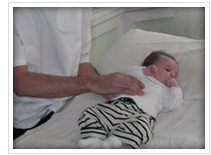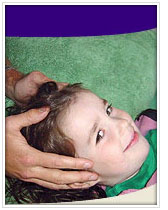|
Babies and Children
 People are often surprised to discover that osteopathy deals with problems relating to babies and children but the osteopathic treatment of infants is an affective method of dealing with many childhood ailments. Often parents and indeed GPs are reluctant to use strong medication for childhood illnesses and today in the United Kingdom osteopaths work in a number of children’s hospitals such as the Great Ormond Street Hospital and Barnet General Hospital. People are often surprised to discover that osteopathy deals with problems relating to babies and children but the osteopathic treatment of infants is an affective method of dealing with many childhood ailments. Often parents and indeed GPs are reluctant to use strong medication for childhood illnesses and today in the United Kingdom osteopaths work in a number of children’s hospitals such as the Great Ormond Street Hospital and Barnet General Hospital.
Although the birth process is quite a traumatic experience, babies are able to cope surprisingly well. However, it is not unusual for the birth to leave its mark on the body and most people have observed the altered shape of a baby’s head immediately after delivery. Less obvious to observe is the effect on the neck, shoulders, body and limbs which are also exposed to strong forces and may affect the functioning of the body.
Osteopaths have a highly developed sense of touch known as palpation. Osteopaths can gather information about the infant’s health by palpating the body, information which is otherwise inaccessible to electronic imagining. Using the hands, osteopaths detect tension in the infant’s neck, thorax, spine or limbs that may be causing the child discomfort.
Cranio-sacral therapy is a method of treatment widely known throughout the world. This method of treatment was first developed by the osteopath Dr. William G. Sutherland in the USA in the early 1900’s. He called the field cranial-osteopathy. Cranial-osteopathy is a method commonly used by osteopaths and fulfils a very important role in the treatment of children. However, it is by no means the only method employed by osteopaths to treat children.
Common childhood complaints
Osteopathy treats a variety of common complaints relating to children. Some of the problems that children suffer with which respond well to osteopathic treatment are listed below:
Problems often suffered by older children:
- Musculo-skeletal problems.
- Ear infections - ‘glue ear’.
- Blocked or runny nose.
- Headache
- Asthma
- Cerebral Palsy
- Down’s Syndrome
At what age should my child be treated?
“As the twig is bent so grows the tree” is a well known osteopathic idiom. It means that any mechanical problem left untreated may lead to more significant problems later on in life. Osteopathy is of benefit for all ages. It is never too early to bring a child for treatment and in some hospitals in the UK it is standard for children to be checked by an osteopath soon after the birth. In Barnet General Hospital in the UK premature babies have been treated by osteopaths for many years.
Osteopathy for babies and toddlers
The stress that the baby’s body undergoes at child birth may lead to discomfort in the head, neck and body. This may cause difficulties with latching on and suckling, and can cause colic and wind. The baby may appear to be in discomfort for no obvious reason. Osteopathy is effective in relieving stresses in the body tissue by removing the tension in the tissues that may be causing discomfort.
Osteopathy for children and teenagers
 Children who have experienced a difficult child-birth may be vulnerable to chronic ear infections and headaches and these may get worse as the child develops. Posture is also an important consideration. As the child reaches puberty and starts to grow at a much faster rate, any postural problems will be exaggerated. Similarly, sports and recreational activities carry a risk of stress and strain on the body. The osteopath analyses the mechanical changes associated with the child’s growth and can make a major contribution to the child’s health and fitness. Children who have experienced a difficult child-birth may be vulnerable to chronic ear infections and headaches and these may get worse as the child develops. Posture is also an important consideration. As the child reaches puberty and starts to grow at a much faster rate, any postural problems will be exaggerated. Similarly, sports and recreational activities carry a risk of stress and strain on the body. The osteopath analyses the mechanical changes associated with the child’s growth and can make a major contribution to the child’s health and fitness.
Visiting an osteopath
When visiting an osteopath, before the examination begins the osteopath and the parents discuss the child’s medical history. The osteopath will enquire about the birth process, the child’s and the mother’s health and any behaviour the parents have observed in the child.
After the medical history the osteopath will ask the parents to remove some of the  child’s clothing so that a physical examination can be performed. The osteopath first observes the child’s posture. Then the osteopath feels the quality of the soft-tissues of the infant’s limbs, spine, ribs, chest, neck and head. The osteopath often combines examination and treatment. In other words the osteopath palpates the soft-tissues of the child and gently treats the areas of tension that the osteopath observes. In osteopathy great emphasis is placed on the spinal column which contains the spinal chord. The spinal chord together with the brain, control the nerve supply to the whole body. The osteopath tries to influence the function and development of the body in both adults and children by applying gentle manual techniques to the spine. For this reason the osteopath dedicates a large portion of the session to work on the spine. The osteopath will of course give due attention to the rest of the body as osteopathy believes that integration of the whole body is key to optimal function. child’s clothing so that a physical examination can be performed. The osteopath first observes the child’s posture. Then the osteopath feels the quality of the soft-tissues of the infant’s limbs, spine, ribs, chest, neck and head. The osteopath often combines examination and treatment. In other words the osteopath palpates the soft-tissues of the child and gently treats the areas of tension that the osteopath observes. In osteopathy great emphasis is placed on the spinal column which contains the spinal chord. The spinal chord together with the brain, control the nerve supply to the whole body. The osteopath tries to influence the function and development of the body in both adults and children by applying gentle manual techniques to the spine. For this reason the osteopath dedicates a large portion of the session to work on the spine. The osteopath will of course give due attention to the rest of the body as osteopathy believes that integration of the whole body is key to optimal function.
After the treatment, the osteopath will explain the findings to the parents and the future treatment plan. The parents should feel comfortable to ask any questions. The osteopath may decide that osteopathic treatment is inappropriate or that further tests need to be performed. In such cases the osteopath will refer the child to another medical practitioner with the parent’s permission.
| 







